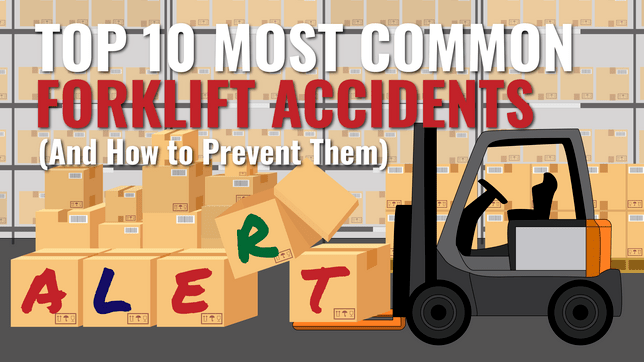This post is all about forklift accidents and safety, including:
- The top 10 most common forklift accidents (in no particular order)
- How employers and operators alike can reduce lift truck accidents in the workplace
- Accident and injury statistics
Let’s dive in.
Statistics
Forklift Rollovers
Rollovers are the most common type of fatal lift truck accident.
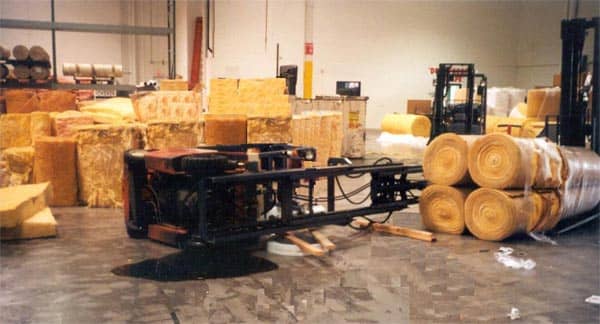
In the event of a tip-over, operators of sit-down forklifts should stay in the seat, brace themselves, and lean away from the point of impact.
Operators of stand-up forklifts should step back and out of the operator compartment and away from the truck.
And as always, wear your seat belt!
Main Causes of Rollovers
- Turning too quickly
- Overweight, uneven, or unbalanced loads
- Abrupt mast movement
- Turning on an incline
- Driving with the load elevated
- Driving on uneven surfaces
How to Prevent Rollovers
Follow set speed limits. This is required by OSHA. Luckily, many forklift manufacturers allow employers to set the speed limit on their trucks to prevent speeding.
Slow down when rounding corners. When turning, the center of gravity of the lift truck can move outside the zone of stability, increasing the risk of tipping over.
Toyota’s System of Active Stability (SAS) uses a cylinder to stabilize the rear axle when it detects instability, helping to keep the truck upright:
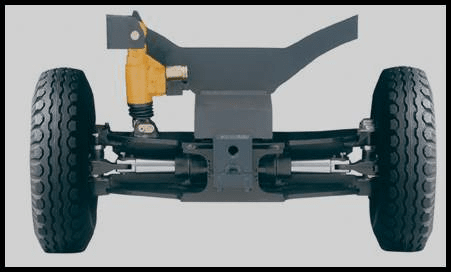
Don’t exceed your lift’s capacity. Check the truck’s data tag if you’re unsure what weight it can handle.
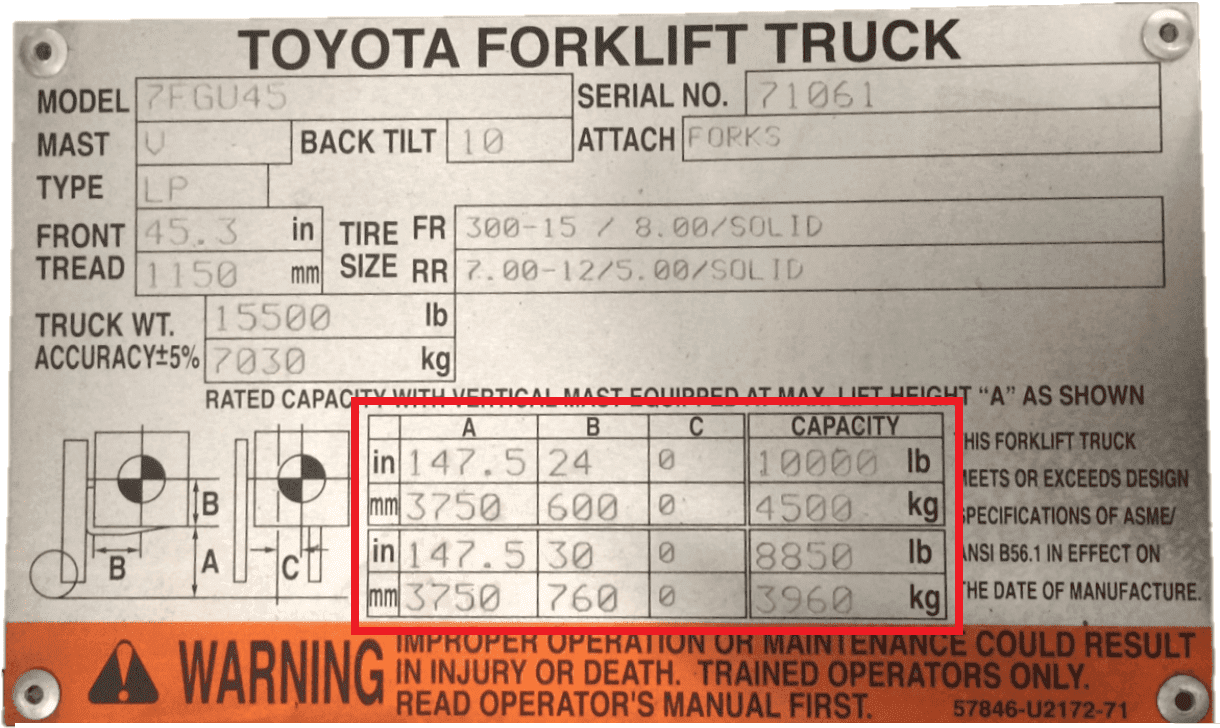
Use care when tilting a raised mast. Tilting too abruptly can cause the forklift to tip forward and over. And only raise or lower the load when the forklift is not moving.
Toyota’s Active Mast Function Control System limits forward and rear tilt speed when instability is detected, helping to prevent tip-overs:
Never turn on an incline. Descend the incline, then turn.
Keep the load as low to the ground as possible. Lift trucks are actually more stable with a load on the forks – so long as the load isn’t elevated.
Only operate on smooth, even surfaces. Potholes and other roadway imperfections can cause the truck to tip over.
Pedestrian Impacts
Forklifts often operate in close quarters with workers on foot.
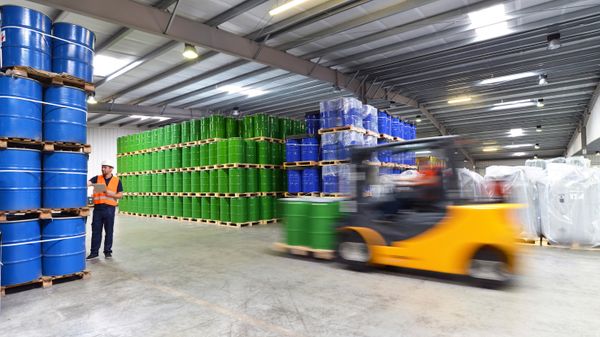
So it’s no wonder that one of the most common types of lift truck accidents involves pedestrians.
Main Causes of Pedestrian Impacts
- Operator inattention, including fatigue, distracted driving, and carelessness
- Lack of warning signs and signals
How to Prevent Pedestrian Impacts
Allow operators more breaks. Long driving shifts without regular breaks can have serious safety consequences. In fact, OSHA reports that workers who work 12-hour shifts are 37% more at risk of injury.
Use care when operating near pedestrians who are next to a fixed object. Lack of operator awareness can easily lead to pedestrians being pinned between the truck and the object.
“Trucks shall not be driven up to anyone standing in front of a bench or other fixed object.” – OSHA 1910.178(m)(1)
Put down floor tape. This can be used to mark pedestrian and forklift traffic, so workers are aware of where to travel safely.
Install barriers. A physical structure can be used to separate forklift traffic from pedestrian walkways, preventing injury when impacts do occur.
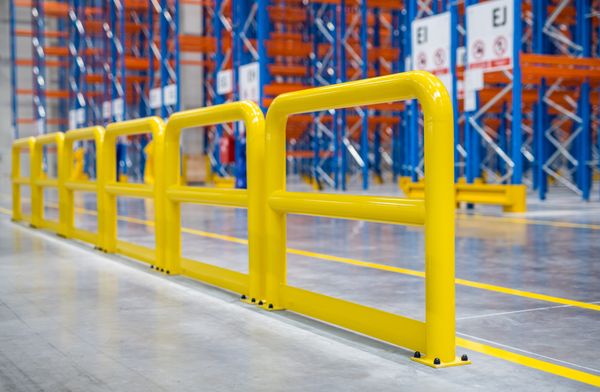
Install wall-mounted mirrors. With mirrors, operators can see around blind spots before proceeding.
Install warning lights on lift trucks. These lights help increase visibility for pedestrians, so they know when a forklift is approaching.
Install travel and/or back-up alarms on forklifts. Especially effective in noisy environments, alarms can alert pedestrians and other operators to the presence of a lift truck in the area.
Lack of Operator Training
OSHA mandates that every operator be trained and certified before using a forklift. Unfortunately, this doesn’t always happen.
When operators are unfamiliar with the proper safety policies and procedures for operating forklift trucks, accidents are bound to happen.
Just take a look at the video below to see how training could’ve helped avoid some serious forklift accidents:
Luckily, inadequate training is easy to overcome. And doing so can decrease the likelihood of injuries while using forklifts.
Main Causes of Inadequate Operator Training
Unknown need. Supervisors and managers may be unaware of the laws on forklift operator training.
Cutting corners. When companies are on a tight schedule and short on time or budget, they may be tempted to skip training just to keep things moving.
How to Prevent Inadequate Operator Training
Sign up for OSHA-compliant operator training. The logic is straightforward: Better training leads to fewer mistakes, which leads to fewer accidents. In fact, OSHA reports that proper training can help reduce forklift accidents by up to 70%!
Check out Conger’s OSHA-compliant forklift operator safety training course
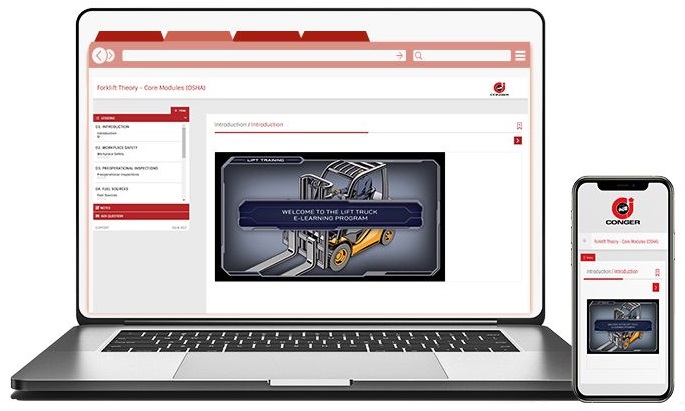
Focus on the return on investment (ROI). Instead of looking at the time and cost of training, companies should look at how much they can actually save. In fact, one survey of chief financial officers (CFOs) found that businesses can earn back $2 for every $1 spent on injury prevention!
Falling Loads
Forklift operators aren’t always tasked with carrying simple loads like boxes and pallets.
Much of the job involves lifting and transporting raw materials, small items, and other loads that can fall if not properly secured.
And falling loads are a hazard to pedestrians and operators alike.
So to prevent injuries and fatalities, care must be taken to ensure loads stay put on the forks.
Main Causes of Falling Loads
- Improper load creation: Off-center, damaged, or loose loads
- Moving, lifting, or tilting the mast too fast
- No load backrest
- Bent forks
How to Prevent Falling Loads
Don’t carry loose or damaged merchandise. Take the time to properly secure loads before transporting. Use banding and/or shrink-wrap to ensure all materials stay on the pallet or forks.
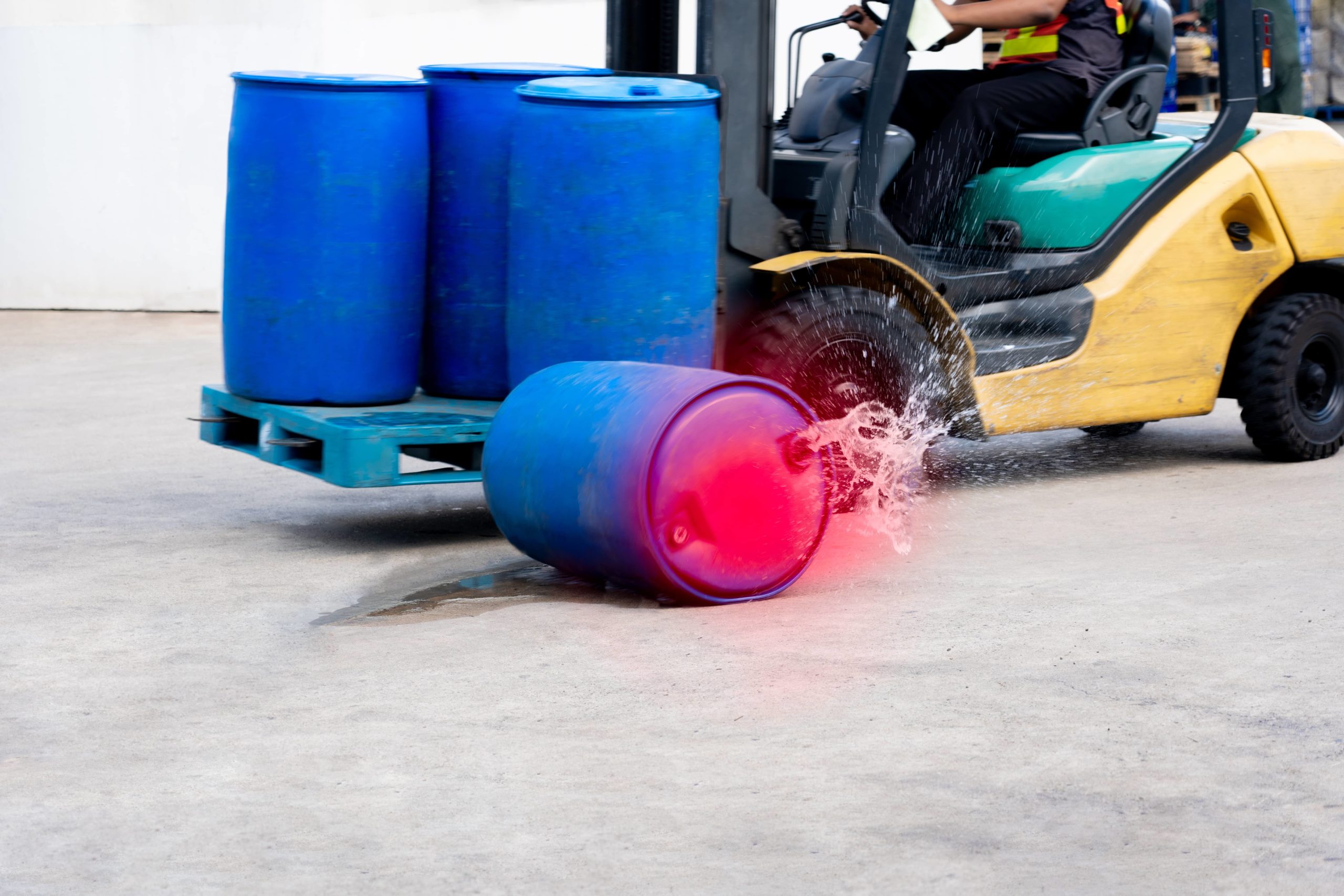
Center the load. If the product can’t be centered, position the heaviest part nearest the front wheels of the lift, against the carriage.
Use care when tilting the mast. Jerky movements, especially when retrieving items from racking, can cause materials to come loose and fall.
Use a load backrest. This will help prevent any items from falling backward into the mast or the operator’s compartment.
Conduct a pre-trip inspection before every shift. Check that the forks are even and that any wear is within acceptable limits. Inspect the overhead guard for structural integrity. It’s not meant to absorb the full impact of a load, but it can guard against small falling objects.
Download Our Free Daily Forklift Inspection Checklist
Print and reuse these inspection checklists as often as you need to. Chose whichever format you’d prefer below and click to instantly download.
Truck Falling Off a Dock or Trailer
One of the most dangerous activities for forklifts is crossing thresholds.
Whether that’s moving between areas of a warehouse or into and out of semi-trailers, operators must be vigilant in making sure it’s safe to proceed.
Main Cause of Falls to Lower Levels
- Trucks or trailers rolling away
- Slippery floors
- Worn or damaged truck or trailer floors
- Improper or no dock plate
How to Prevent Falls to Lower Levels
Chock truck/trailer wheels before entering. The weight and forward movement of a forklift entering a trailer or truck can cause it to lurch forward if the wheels aren’t secure.
“The brakes of highway trucks shall be set and wheel chocks placed under the rear wheels to prevent the trucks from rolling while they are boarded with powered industrial trucks.” – OSHA 1910.178(k)(1)
Slow down when approaching the dock. Check for liquids on the ground and clean them up before proceeding.
Inspect the floor of the truck or trailer before driving on it. Missing boards, uneven floors, or debris can lead to a fall.
“…The flooring of trucks, trailers, and railroad cars shall be checked for breaks and weakness before they are driven onto.” – OSHA 1910.178(m)(7)
Ensure the dock plate is properly placed and rated for the weight of the truck plus the load. Dock plates can shift if not properly positioned. And they can buckle if their weight capacity is exceeded.
Personnel Falling from Forks
No one should ever stand on the forks of a forklift and be elevated.
While it may be tempting for convenience-sake, the chance of falling is extremely high.
Head trauma, broken bones, internal bleeding, and even impalement can happen in personnel who choose to “ride the forks.”
Main Causes of Personnel Falls
- Prioritizing speed and convenience over safety
- No aerial lifts available
- Unapproved or unrestrained lifting platforms
How to Prevent Personnel Falls
Slow down and don’t cut corners. Take the time to select the right tools for the job, even if it takes extra time.
Use the proper equipment. A scissor lift, man lift, or other purpose-built mobile elevating work platform (MEWP) are far better options for safely reaching heights.
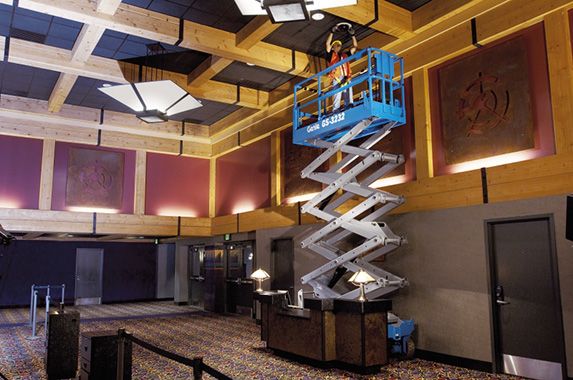
Use an OSHA-compliant lifting cage. It should have guardrails and a barrier separating the personnel from the mast. Personnel in the cage should also wear a harness. And make sure the platform is attached to the lift to prevent it from shifting and/or falling.
Blocked Sight
If the lift truck operator can’t see where they’re going, it’s a recipe for disaster.
It’s not just tall loads that can decrease visibility either.
Operators need to be aware of their sides and rear blind spots to avoid colliding with pedestrians, products, equipment, and infrastructure.
Main Causes of Blocked Sight Incidents
- Driving forward with tall loads
- Driving with elevated forks
- Not checking blind spots around the lift truck
How to Prevent Blocked Sight Incidents
Only travel in the direction you can see. If you have a tall load on the forks, drive backward until you reach your destination.
Have a colleague act as a spotter. If you can’t see forward and it’s not possible to drive backward, have a trusted coworker guide you.
Keep the forks low to the ground. Never drive with an elevated mast. It not only reduces visibility, but it can cause the lift truck to become unstable and tip over.
Be aware of tailspin and clearance when turning. Forklifts steer with the rear axle. If the operator isn’t paying attention to their surroundings, the counterweight can ram into pedestrians, damage products, or even take down an entire storage rack:
Mechanical Failures
Forklifts are just like any other piece of machinery: They need to be maintained regularly.
When fork trucks are left to languish under the conditions of work, breakdowns and safety issues are sure to result.
Main Causes of Mechanical Failures
- Worn brakes
- Leaks: Fluids on the floor are a slipping and stopping hazard
- Worn or damaged tires
How to Prevent Mechanical Failures
Conduct pre-shift inspections. OSHA requires that operators check their trucks before operating. This exercise can help identify problems both big and small. And correcting those issues is key to the continued optimal and safe operation of the lift.
“Industrial trucks shall be examined before being placed in service, and shall not be placed in service if the examination shows any condition adversely affecting the safety of the vehicle. Such examination shall be made at least daily. Where industrial trucks are used on a round-the-clock basis, they shall be examined after each shift. Defects when found shall be immediately reported and corrected.” – OSHA 1910.178(q)(7)
Regularly service your equipment. Sign up for a preventative maintenance (PM) program from a quality service center and keep to it.
Pull equipment from service until any issues are corrected. If major problems are found, don’t operate the lift. Lock and tag the truck out and schedule the repairs.
Emissions Poisoning
While battery-powered forklifts are steadily becoming the preferred choice for many businesses, internal combustion (IC) fork trucks are still in wide use.
Fortunately, advances in emissions technology over the years have led IC lift trucks to produce fewer and fewer emissions.
But operating these kinds of trucks can still present hazards to employees.
Main Causes of Emissions Poisoning
- Operating in confined spaces
- Poor ventilation
- Excessive idling
- Incorrect fuel mixture
- Leaking exhaust
How to Prevent Emissions Poisoning
Ensure operators are aware of the risks of confined spaces. Using lift trucks in storage sheds, semi-trailers, and small rooms can cause a quick build-up of lethal carbon monoxide (CO) gas.

Install ventilation systems. These will circulate the air and help remove noxious gases.
Install carbon monoxide monitors. These can alert everyone in the area to dangerous gas build-ups and give time to evacuate.
Schedule regular maintenance. Maintenance routines should include adjusting the fuel mixture and checking for exhaust leaks.
Crushed by Forklift
Crushing hazards are one of the top causes of forklift injuries and fatalities for pedestrians.
Pedestrians can become pinned between the truck and a fixed object if the operator isn’t paying attention – with often fatal results.
Main Causes of Crushing Accidents
- Inattentive backing
- Crushed by the mast while tilting
- Loose materials falling off the forks
How to Prevent Crushing Accidents
Look before putting the truck into motion. Operators should scan their surroundings, especially behind them, before putting the truck into gear and moving.
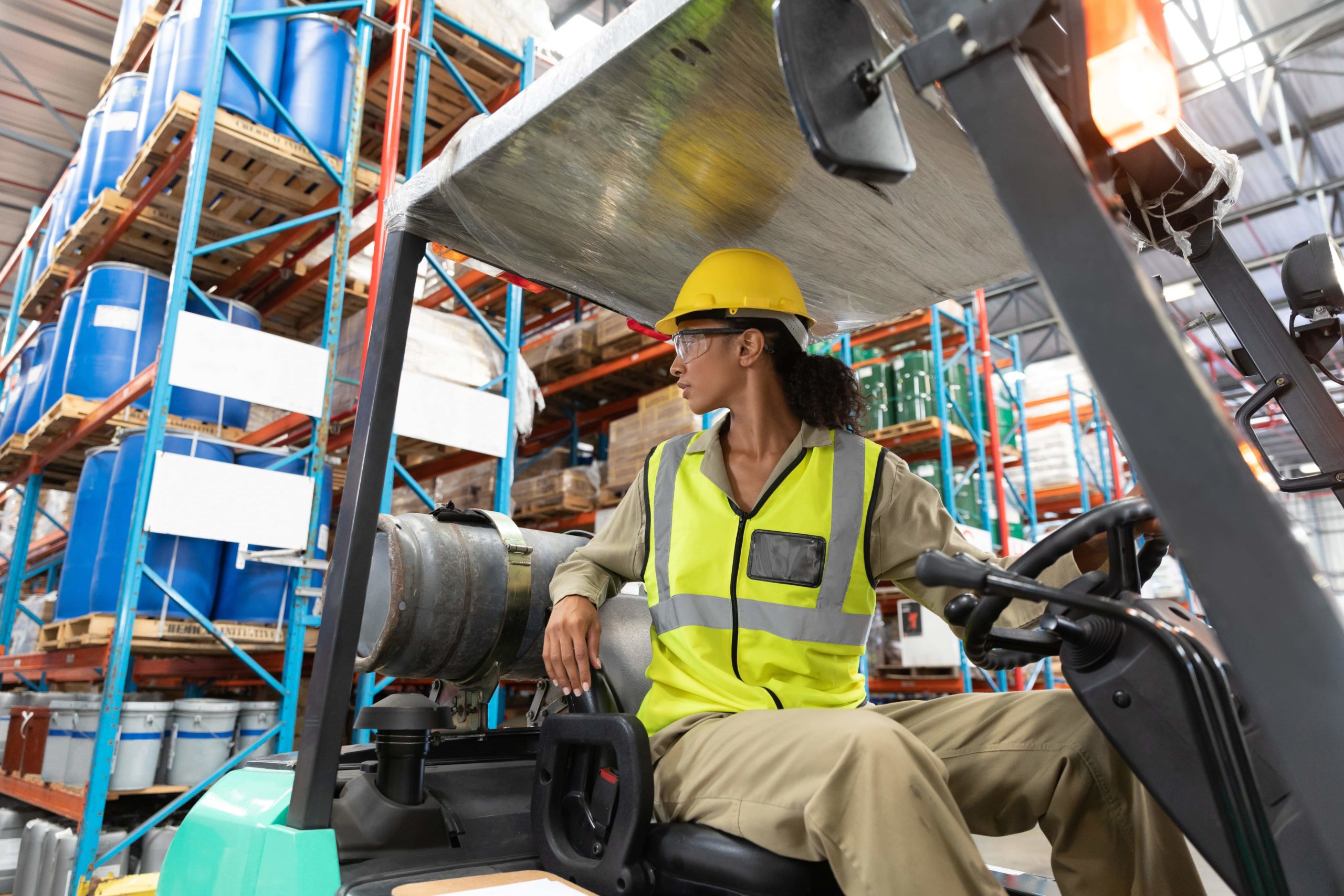
Never drive up to a pedestrian standing next to a fixed object. If the brakes fail or the floor is wet, the truck will crash into the pedestrian, crushing them in the process.
Never leave the operator’s compartment during operation of the truck. Don’t put any body parts inside the mast or between the mast and the firewall of the truck.
Properly secure the load. Heavy or awkward loads can come loose, landing on pedestrians or the operator.
Forklift Accident Statistics
Now that you know all the most common forklift accidents, let’s dig into the actual numbers.
Truth be told, the statistics on forklift accidents are a bit spotty.
But we managed to pull together what we could from the most reputable sources, including:
- U.S. Bureau of Labor Statistics
- Occupational Health and Safety Administration (OSHA)
- National Institute for Occupational Safety and Health (NIOSH)
- National Safety Council (NSC)
How Many Forklift Accidents Happen Every Year?
OSHA’s most recent estimates indicate that between 35,000 and 62,000 injuries occur every year involving forklifts.
The U.S. Bureau of Labor Statistics reported that in 2017, there were 9,050 forklift-related injuries serious enough to cause employees to take time off work. In 2018, that number went down to 7,940.
Forklift injuries tend to be more serious than other workplace injuries. The median number of days off work was 13, compared to 8 days for all other cases.
And when you consider that each injury that requires medical attention costs companies an average of $41,000, it’s clear how high both the human and financial costs are for forklift accidents.
How Many People Die in Forklift Accidents?
About 75 to 100 workers are killed annually in forklift accidents, with a rough average of 87 deaths per year.
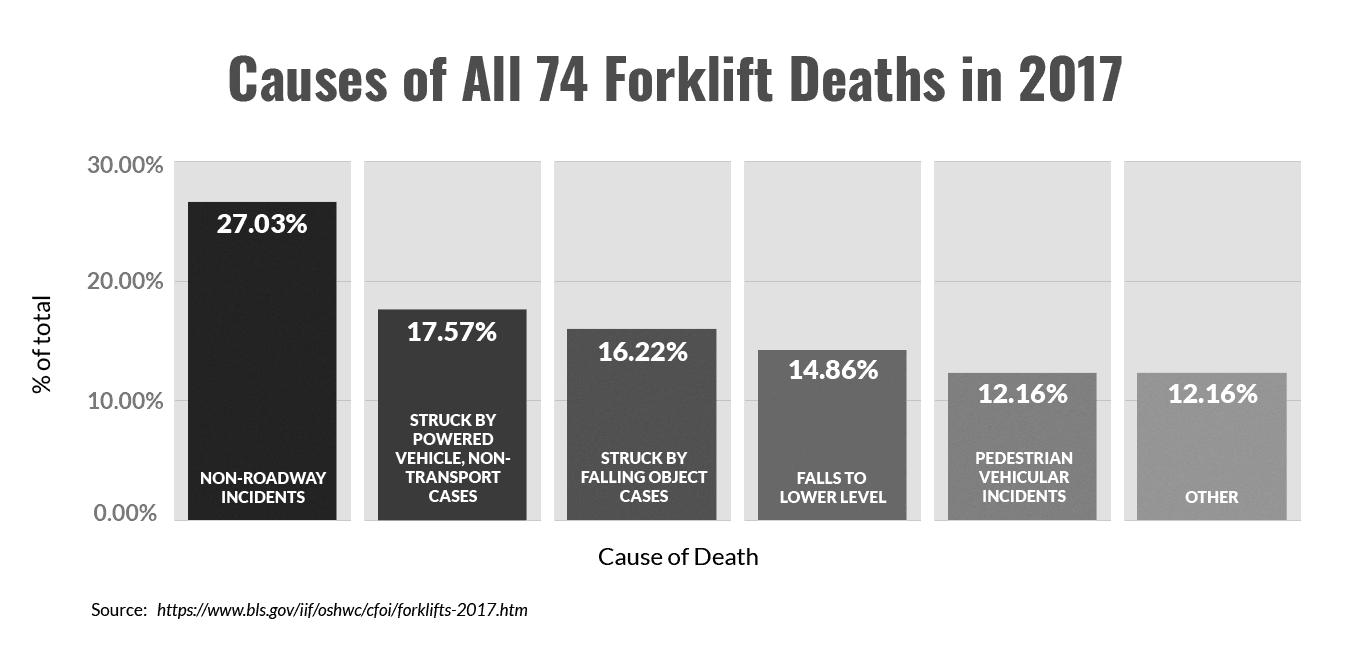
Here are exact numbers for years where the data was available:
- 1980-1994: 1021 deaths
- 1995: 94 deaths
- 2011-2017: 614 deaths
- 2015: 96 deaths
- 2017: 74 deaths
- 2018: 85 deaths
What Percentage of Forklift Accidents Involve Pedestrians?
While the exact numbers fluctuate year to year, forklift accidents involving pedestrians are nearly always at the top of the list.
Data from 2017 provided by the U.S. Bureau of Labor Statistics shows that pedestrians were involved in 20% of non-fatal accidents and 13% of fatal ones.
Here’s the full breakdown of forklift accidents by type:
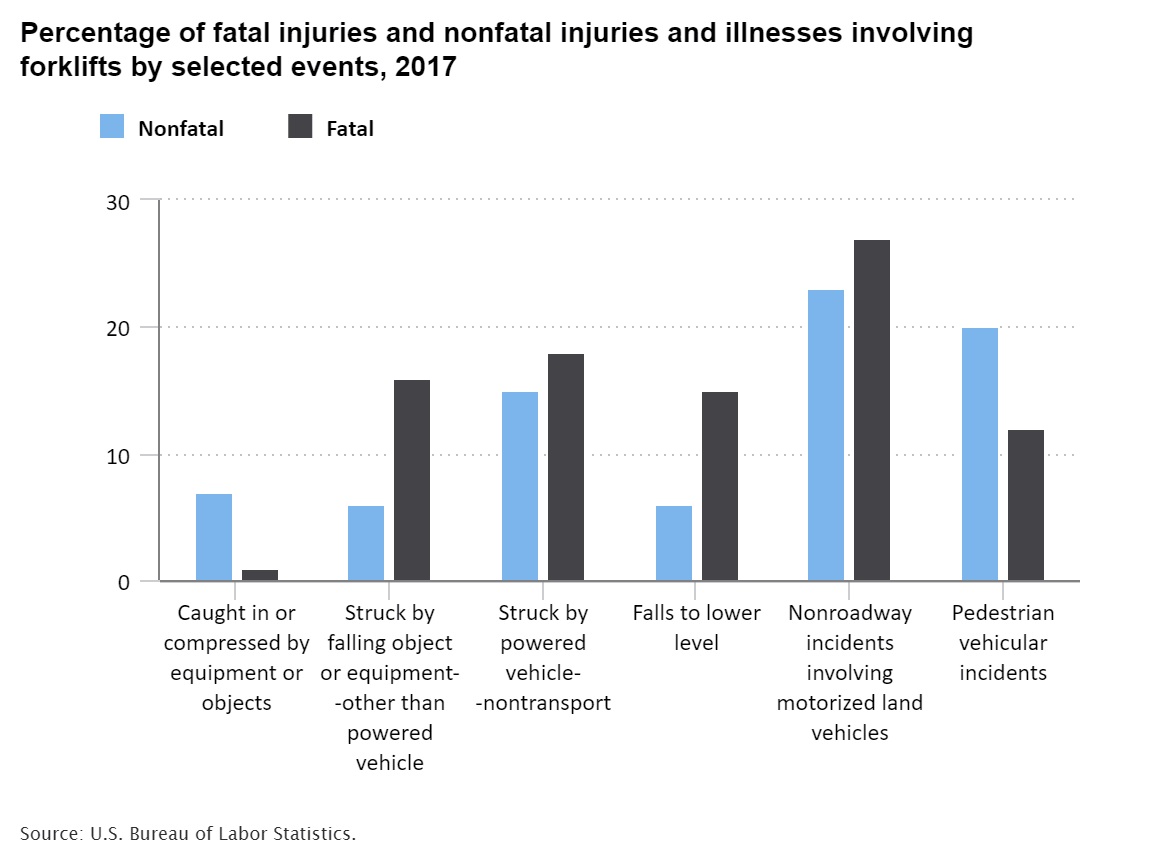
Forklift Safety: The Human and Business Costs
The infographic below summarizes just how much forklift accidents cost both in human and business terms.
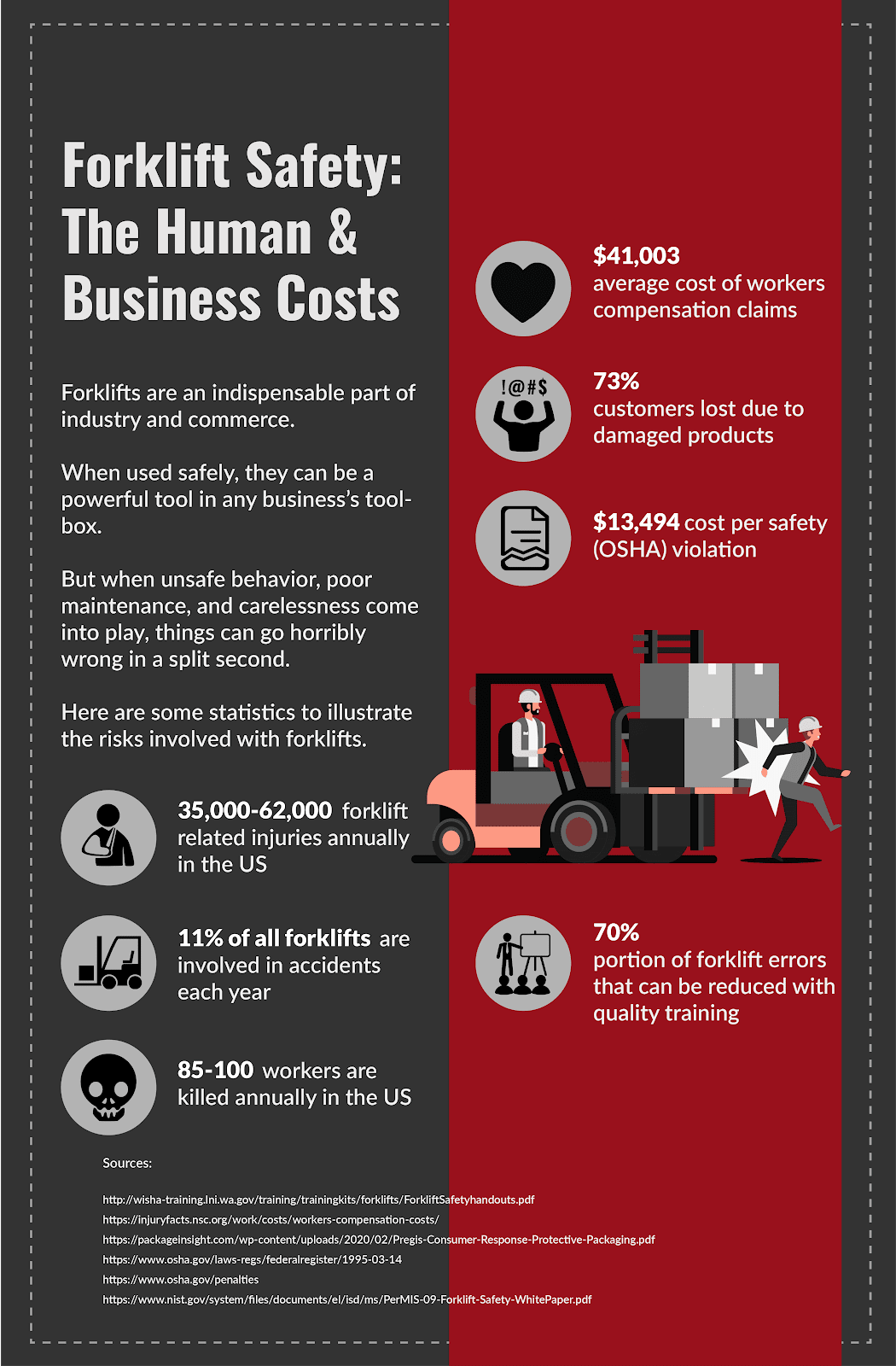
Conclusion
There you have it: The most common forklift accidents and how to prevent them.
Now, we’d like to turn it over to you.
What are some forklift hazards you see in your day-to-day work?
What steps have you or your company taken to promote safe forklift operations?
